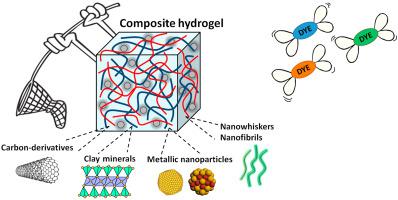Journal of Cleaner Production ( IF 9.7 ) Pub Date : 2020-10-17 , DOI: 10.1016/j.jclepro.2020.124703 Antonio G.B. Pereira , Francisco H.A. Rodrigues , Alexandre T. Paulino , Alessandro F. Martins , André R. Fajardo

|
Dye-contamination in water supplies, industrial effluents, and rivers is one of the major water pollution issues. It has put at risk the drinking-water supplies around the globe. Various remediation approaches have been extensively developed and tested to minimize this worrying scenery. In particular, adsorption techniques are often ranked as one of the most prominent strategies to treat dye-contaminated water likely due to their attractive practical and economic advantages. Overall, the efficiency of adsorptive removal of dyes from water is closely related to the adsorbent material features, which has a critical role in this process. Currently, thousands of materials (raw or processed) have been tested as adsorbents. Otherwise, none of them have achieved the prominent status assigned to the hydrogels. Frequently labeled as an ideal adsorbent, the leading role of these soft materials towards the adsorptive removal of dyes from the water was consolidated almost two decades ago, when the introduction of different materials into the hydrogel matrices resulted in composite materials with unique properties. In this paper, an entirely conceptual and critical review of literature is presented, focusing on the tremendous potential of composite hydrogels to remediate dye-contaminated water. Specifically, the main advances related to the use of composite hydrogels containing clay minerals, carbonaceous materials, organic fibrils and whiskers, magnetic and metallic particles, and other inorganic fillers are reviewed in this paper. Additionally, general methods to prepare composite hydrogels, the main effects ascribed to the composite formation are addressed in this paper. Finally, the main drawbacks and challenges associated with the application of these types of hydrogels are reviewed to understand the research gap and limitations regarding their practical use. We believe that the information provided in this review paper may contribute to enhance the scientific basis for the practical and efficient use of these fascinating adsorbent materials.
中文翻译:

用于修复染料污染的水和废水的复合水凝胶的最新进展:综述
供水,工业废水和河流中的染料污染是主要的水污染问题之一。它使全球的饮用水供应面临风险。已经广泛开发和测试了各种补救方法,以最大程度地减少这种令人担忧的风景。特别是,吸附技术由于其有吸引力的实用和经济优势,经常被视为处理染料污染水的最重要策略之一。总的来说,从水中吸附去除染料的效率与吸附材料的特性密切相关,这在此过程中起着至关重要的作用。目前,已经测试了数千种材料(原始或加工的)作为吸附剂。否则,它们都没有达到水凝胶的突出地位。通常被标记为理想的吸附剂,近二十年前,当将不同的材料引入水凝胶基质中形成具有独特性能的复合材料时,这些柔软材料对从水中吸附去除染料的主导作用就得到了巩固。在本文中,提出了一个完全概念性和批判性的文献综述,重点是复合水凝胶在修复被染料污染的水中的巨大潜力。具体而言,本文综述了与使用包含粘土矿物,碳质材料,有机纤丝和晶须,磁性和金属颗粒以及其他无机填料的复合水凝胶有关的主要进展。此外,本文还讨论了制备复合水凝胶的一般方法,归因于复合物形成的主要作用。最后,回顾了与这些类型水凝胶的应用相关的主要缺点和挑战,以了解有关其实际用途的研究差距和局限性。我们认为,本综述文件中提供的信息可能有助于增强实用和有效使用这些引人入胜的吸附剂材料的科学基础。











































 京公网安备 11010802027423号
京公网安备 11010802027423号